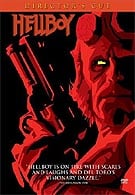The measure of a man isn’t made by how he starts out life, but by the choices he makes along the way. That’s the lesson we’re offered in Guillermo Del Toro’s Hellboy. It’s a nice touch to have a comic book movie with a moral, making it a kind of modern sci-fi fable. Granted, Aesop’s stories never included things like re-animated dead, pyrokinetic heroines or demonic portals into deepest space, but that doesn’t stop Del Toro’s storytelling from being just as enlighteningly entertaining, in a creepy, supernatural, comic book sort of way. Like so many good sci-fi action movies, Hellboy’s tale begins with Hitler. While history records the Fuhrer busily conquering the world through more traditional methods, Conspiracy theorists and Hollywood have him dipping his hand in every religious cookie jar possible to achieve global domination. When he wasn’t chasing down Jewish relics to build an invincible army or seeking out Christian artifacts to attain immortality (a la the Indiana Jones films), he was teaming up with Russian legend Grigori Rasputin to channel ancient occult powers into the Third Reich’s arsenal. Such is the premise for Hellboy.
On a cold, wet night near the end of World War II, a secretly dispatched team of U.S. soldiers descends on a secret ceremony being held by a secret society, funded by an even more secret branch of the Nazi army (all that secrecy…it must be a comic book movie!). Rasputin (Karel Roden), at the behest of Hitler and his occult buddies in the Thule Society, is preparing to open a doorway into deepest space to usher in the ultimate malevolent power in the universe (who, upon arriving will naturally side with Hitler).
The U.S. soldiers quickly break up the party and destroy the portal, killing Rasputin in the process, but something still manages to come through from the other side before the portal is shut down: a pint sized Hellboy (Ron Perlman). The U.S. team’s occult specialist, Dr. Trevor 'Broom' Bruttenholm (John Hurt) quickly recognizes the potential of such a find and saves the little guy from being killed by the trigger happy soldiers, choosing instead to raise the supernaturally powered, red skinned beasty as his own son.
Fast forward sixty years or so to the present day. The FBI has established the top-top secret Bureau of Paranormal Research and Defense. A sort of MIB for things that go “bump in the night”, the organization consists of Professor Broom, Hellboy, and Abe Sapiens (Doug Jones, unmistakably voiced by the uncredited David Hyde Pierce), an apparently immortal merman creature with incredible psychic powers. When Rasputin suspiciously pops back up on the radar (he has a nasty habit of being sent back from the other side), the Bureau is called in. It slowly becomes clear that Rasputin has big plans for Hellboy and is willing to use anyone to achieve his goal, including Hellboy’s pyrokinetic love interest, Liz Sherman (Selma Blair). Along the way, newbie FBI special agent John Myers (Rupert Evans) must find a way to fit in with the FBI “freak show” and help Hellboy discover that no matter how we come into this world, the choices we make are what define who we are.
Make no mistake, the director’s cut of this film adds some much appreciated tidbits to the Hellboy story. The newly added footage will disappoint fans who were looking for the kinds of eerie sci-fi gore and violence that would never pass the MPAA. What you do get is a movie with a few more details and story development that for no discernable reason other than time constraints were cut from the original release. The added scenes are excellent and fit perfectly into the storyline without halting the action at all. Why they were removed in the first place is a mystery to me.
The characters that benefit the most from the expanded scenes are Hellboy, Liz and Professor Bloom. The stories behind their conflicted relationships receive more attention, and rightly so. Ron Perlman, a character actor well known to sci-fi fans, finally lands himself a strong lead role only to have some of the good plot moments related to his character inexplicably removed for the official release? For shame!
When it’s all said and done, the director’s cut of Hellboy still falls short in the plot and character development department, despite the touted 13 minute booster shot (blame Del Toro, who not only directed but also wrote the screenplay). Still, it’s a fun comic book flick with serious repeat-watchability qualities. Okay, so it lacks the depth of Raimi’s Spiderman and the character development of Singer’s X-Men. But who needs all that when you’ve got giant demonic space aliens and epic occult conspiracies. To boot, Del Toro has a dark visual style that is stunning to behold and well suited to the epic nature of the Hellboy story.
Your Daily Blend of Entertainment News
If you’ve got a thing for ancient, god-like, tentacled monsters or a fetish for hating stuck-up FBI supervisors, Hellboy is a comic movie for you. Otherwise, feel free to go back to cursing Singer for abandoning the X-men and hoping that Superman won’t be a total loss. There aren’t a lot of directors out there who pay as much attention to what the DVD of their film is going to be as they pay to the film itself. If Peter Jackson is their king, Guillermo Del Toro is the crown prince. Attached to the director’s cut of Hellboy is a three disc set of materials that are the exhaustive guide to watching and understanding the film.
Lush menus are what immediately greet you, followed by an introduction to the materials of each of the three discs, given by Del Toro, Blair and Perlman respectively. Beyond that is a maze of bonus materials that, if properly explored, will keep you busy for many hours to come. Unfortunately, there is no helpful printed map of bonus features like you would expect to find in such an anthology. Instead there is a perfectly useless gimmick item: an undecipherable collection of pages from Rasputin’s prop diary. Anyone want mine? Send me an e-mail.
Across the disc set, there are four different ways to watch the film. Naturally there is the film itself, followed by the accompaniment of Guillermo Del Toro’s commentary. He barely stops to take a breath as he expounds on the background of the story and history of the comic, the characters and filmmaking process. The only thing thicker than the depth of his commentary is his accent, which once you get used to, is easy enough to tune out.
Third time around is a unique sort of actor commentary with Perlman, Blair, Evans and Jeffrey Tambor (who plays FBI Head of Special Operations Tom Manning) . Unlike most commentaries, the actors are shown instead of the show. Most of the time the film itself is relegated to a little screen in the corner while the actors just sit there and talk. It’s a novel idea and a worthy attempt, but ultimately uninteresting to watch. The actors seem very aware that they are being video taped and don’t relax much into their discussion of the film.
The fourth version is my personal favorite. Hellboy’s music composer Marco Beltrami discusses his work on a track with an isolated score. Along with hearing the magnificent music standing on its own, you get to see it set against the movie’s visuals without dialogue or sound effects, which is an interestingly exciting way to watch the movie. Beltrami also spends some time pointing out the intricacies of composing themes and score for a film, enjoyable for folks like myself who love movie soundtracks. He’s even bold enough to make humorous, but well-deserved smart aleck observations about the film, like why Hellboy’s jacket doesn’t burn when Liz has an episode near the end of the movie. But the best parts are when Marco clams up and lets his music speak for itself.
Hellboy: The Seeds of Creation is the making-of featurette that covers every single aspect of the production, from conception to premiere. It’s cleverly laid out to be watched either as a full length movie or in sections, allowing you to pick and choose the aspects that you want to view. While each chapter is interesting unto itself, the full-length version feels a little choppy. For my money, you’re better off picking the titles that look appealing and watching them by themselves instead.
One of the more unique additions to the package is titled A Quick Guide to Understanding Comics with Scott McCloud. McCloud, something of a comic aficionado, discusses the history and significance of comics as a storytelling device. His thoughts are fascinating and he explores the concept of comics in a way that sheds a smart light on how the storytelling method is adapted for film.
The list of lesser bonus features is seemingly endless. With a DVD-ROM reader on your PC you can download and print a copy of the screenplay and portions of Del Toro’s personal notebook. There is a spliced together video of a Q&A session from Comic-Con featuring Del Toro and Hellboy creator Mike Mignola. There are tons of production materials such as storyboard comparisons, 3-D rotating maquettes, photo galleries, animatics and far more. Basically, Hellboy movie and comic fans will go into geek seizures of joy over what Del Toro has included.
A lot of fans out there seem bitter than Del Toro came out with such a complete set just months after the two disc special edition was released. My thoughts? GET OVER IT!! Del Toro apparently announced both versions at the same time, so for those who got stuck double dipping: neener neener nee-ner. You have no one but yourself to blame. For my money, the extra few dollars make getting the three disc set well worth it. Splurge!

